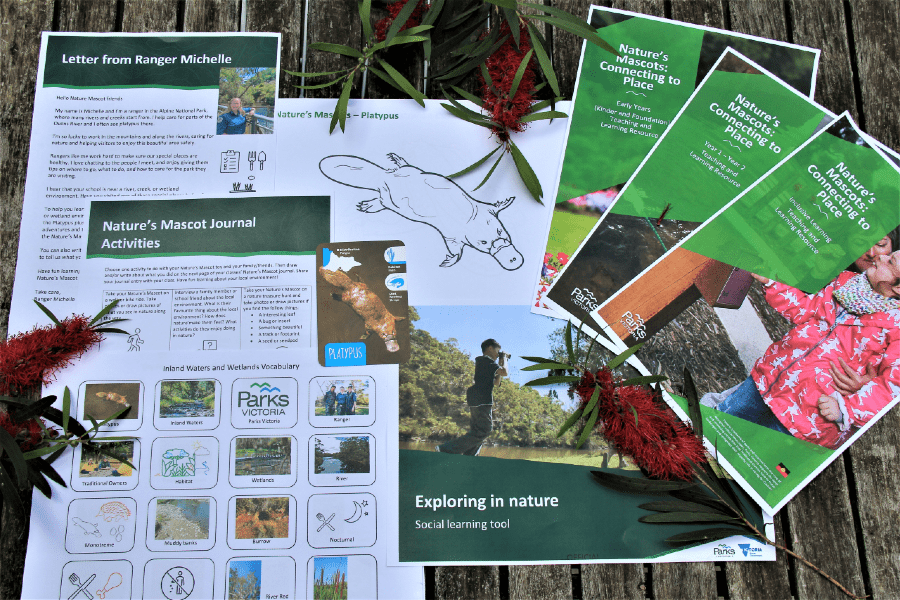Nature's Mascots
Why is nature important to living things?
Kinder to Year 2 students are encouraged to explore this question through Parks Victoria’s free early years education program: Nature’s Mascots.
The Nature’s Mascots program is a place based, inquiry program which connects students to their local green spaces through one of ten Nature’s Mascots that represents their local ecosystem.
| Ecosystem |
Mascot Animal |
| Alps | Alpine Tree Frog |
| Coastal | Red-necked Stint |
| Dry Forests | Brush-tailed Phascogale |
| Grasslands | Striped Legless Lizard |
| Heathlands | White-footed Dunnart |
| Inland Waters and Wetlands | Platypus |
| Mallee | Malleefowl |
| Marine | Giant Australian Cuttlefish |
| Urban | Grey-headed Flying Fox |
| Wet Forests and Rainforests | Yellow-bellied Glider |
Supporting resources strongly link to the Levels A-D and Foundation-Year 2 Victorian Curriculum areas of Science, Geography, Critical and Creative Thinking and the cross-curriculum priorities of Sustainability and Aboriginal Histories and Cultural along with connections to the five outcomes in the Victorian Early Years Learning and Development Framework.
The program and its accompanying resources are based on Parks Victoria's Learning for Nature education philosophy: Connect, Learn, Protect. This structure is designed to:
- build on early connections to nature and local places
- strengthen resilience and belonging to community
- foster pro-environmental values
The Nature's Mascot program was funded by the Department of Education through their Strategic Partnerships Program.
Program overview
The video below is a case study of Kinglake Primary School’s experience integrating the Nature’s Mascot education program into their Foundation – Year 2 inquiry unit.
Access the resources
The free Nature’s Mascots Teaching and Learning Resource Packs is available for download here. These packs can be used as a full unit of work however teachers are encouraged to adapt and use the activity ideas that suit their students' needs, inquiries and interests.

A sample of resources to support students to connect with and learn about one of the ten Nature's Mascots.
Nature's Mascot
Educators can choose to purchase a Nature’s Mascot toy to support student learning. We would encourage you to support locally made toy manufacturers and/or people who follow fair trade principles.
The Teaching and Learning resource pack contains information about suggested suppliers of Nature’s Mascots.
Supporting resources
Acknowledgement of Country
No matter where we are in Australia, we're walking on someone’s Country. We are all so fortunate to play, learn and live on the lands and the waters of the oldest living cultures on Earth. Use the resources below to learn about whose Country you're learning on.
Registered Aboriginal Parties of Victoria
Explore the Registered Aboriginal Parties map to find out whose Country your school is on. Links to each Aboriginal group's webpage provide further details about how to get in contact and make connections with your local Traditional Owners.
Australians Together
The Australians Together website contains free curriculum aligned resources that have been co-designed with First Nations people to increase understanding of our shared history and its ongoing impact.
NAIDOC teaching resources
The NAIDOC teaching ideas developed by the National NAIDOC Committee relate directly to supporting teachers in addressing The Australian Curriculum: Aboriginal and Torres Strait Islander Histories and Culture cross-curriculum priority.
Literacy resources
Parks Victoria's literacy resources help young learners to build on their understanding of Aboriginal culture and nature conservation through informative text and engaging visuals.
Picture Story Books
A list of Parks Victoria recommended picture story books that support the themes within the Nature’s Mascot program.
- Picture Story Books that support Nature's Mascot program (DOC)
- Picture Story Books that support Nature's Mascot program (PDF)
Nature's Mascots information posters
Animal hero literacy resources help emergent and fluent readers to build connections to places and understand how to care for both habitats and species.
Digital nature conservation storybooks
Parks Victoria's digital picture books use science-informed narrative and illustration to communicate conservation stories to young children.
Learning for Nature videos
The video resources found on Parks Victoria's Learning in Nature YouTube playlist highlight how science, geography and Aboriginal culture and history inform Parks Victoria's management of Victoria's protects places. These short stories provide authentic, real-world examples that build students' environmental literacy and cultural understanding.

